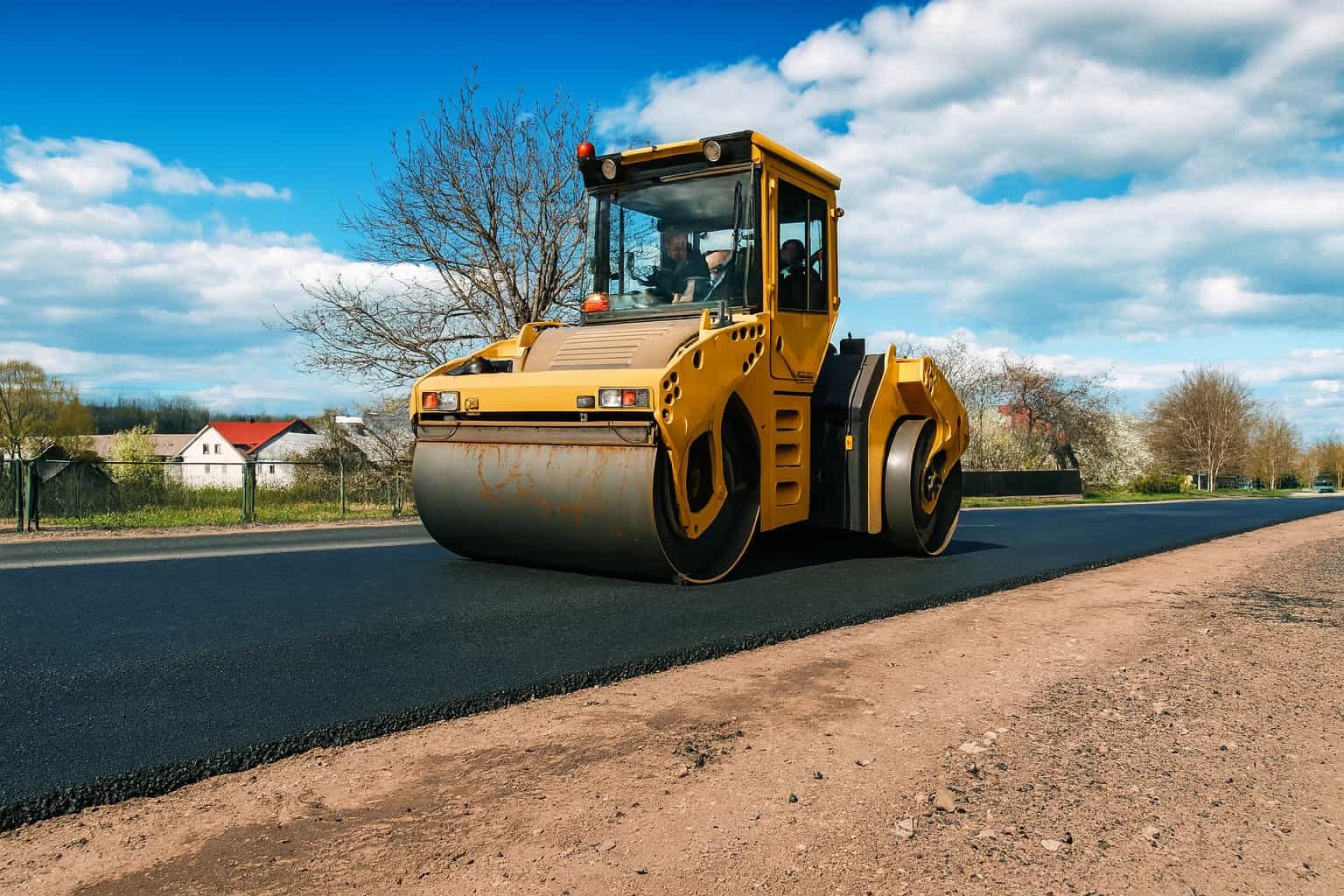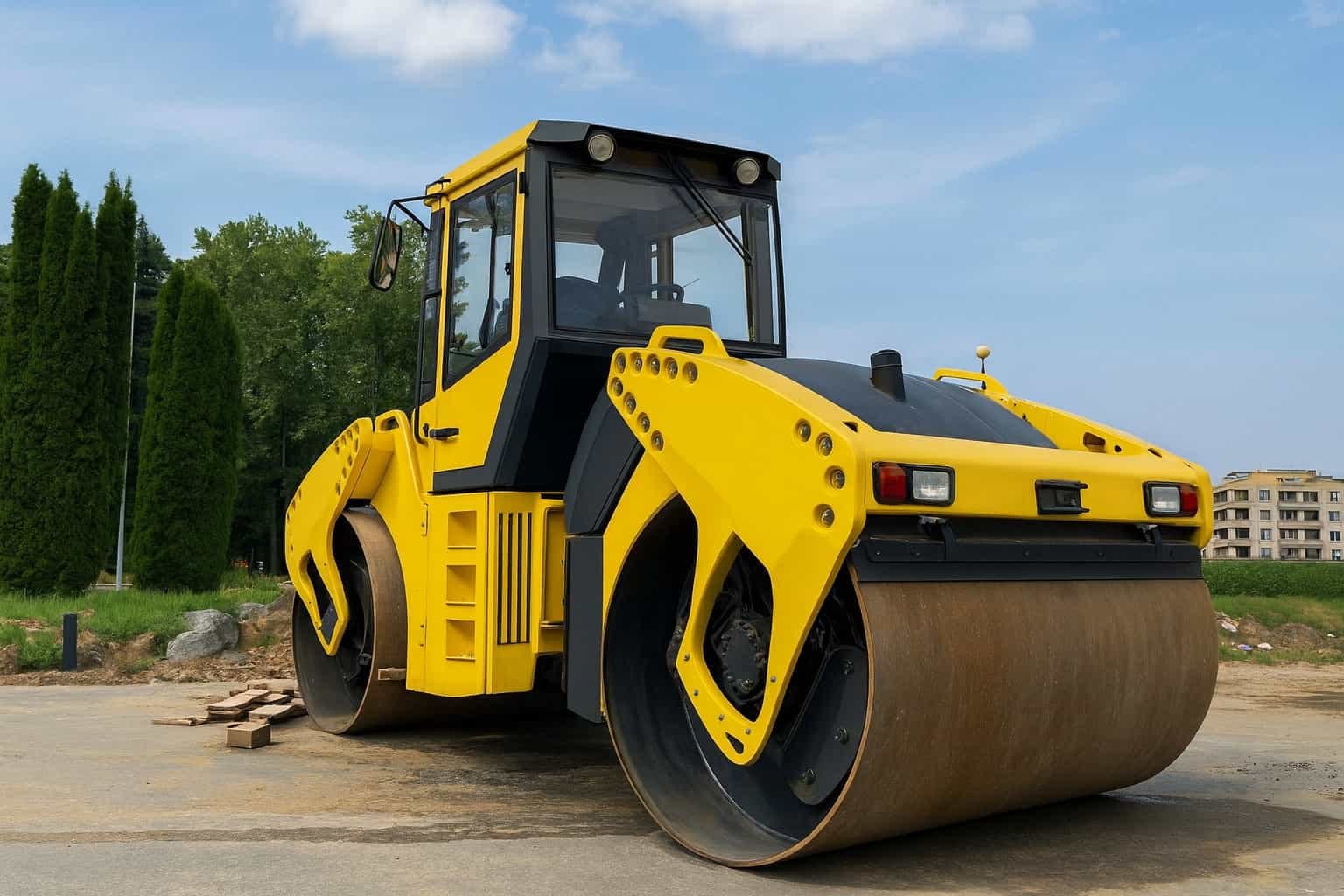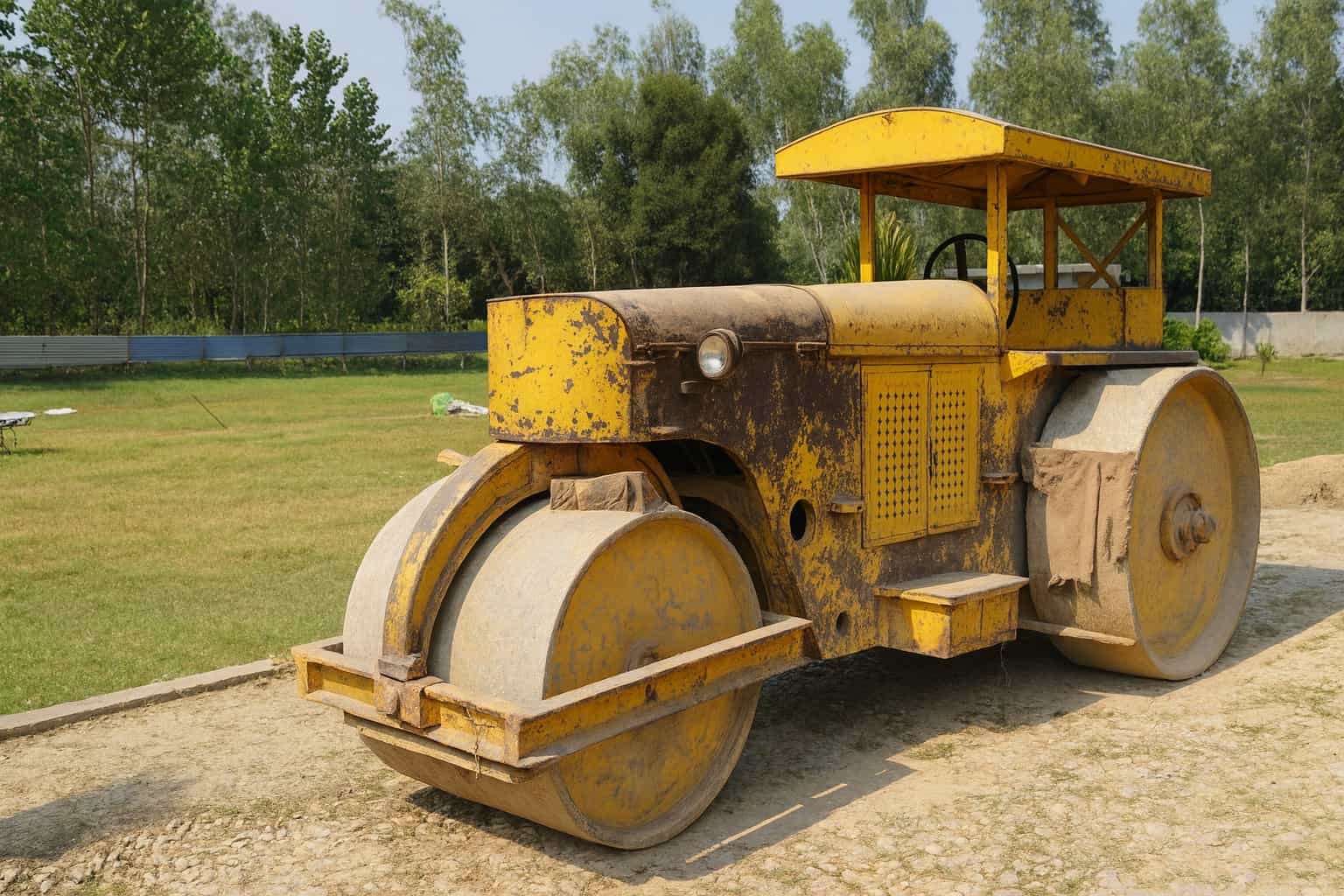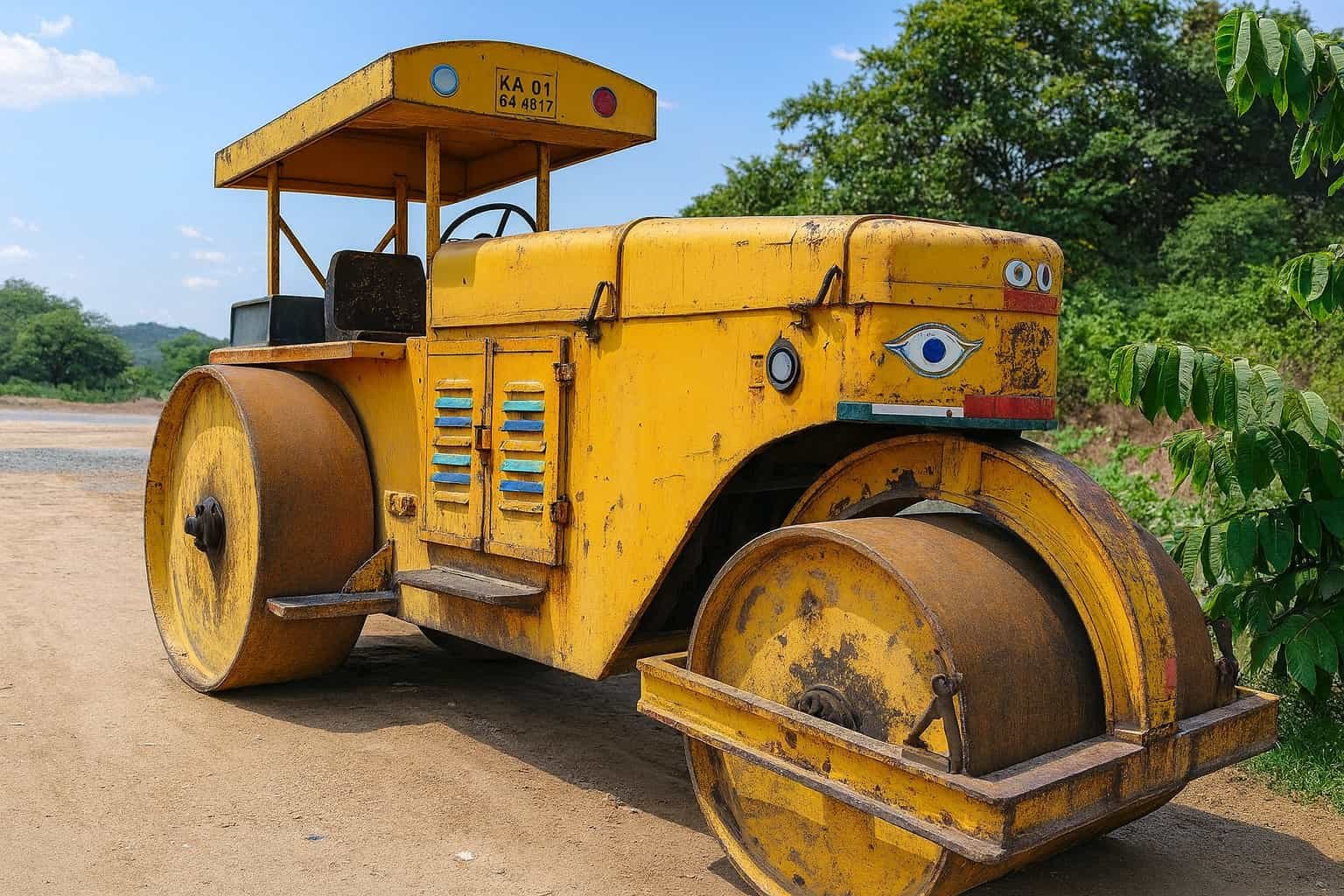What is a Road Roller?
A road roller, also known as a roller-compactor, is a heavy-duty construction machine used to compact soil, gravel, asphalt, and other materials during road construction and base layer applications. It ensures a level and stable surface.

Key Functions of a Road Roller
- Compaction: Uses its heavy weight and vibration to compress materials.
- Smoothing: Flattens and smooths surfaces for road and foundation construction.
- Stability: Enhances ground stability by increasing material density.
Types of Road Rollers
- Static Rollers: Utilize their weight for compaction.
- Vibratory Rollers: Use both weight and vibratory force.
- Pneumatic Rollers: Equipped with rubber tires for uniform pressure distribution.
How It Works
- Weight Application: Heavy drums apply pressure to the surface.
- Vibration Mechanism: Vibratory rollers use a vibrating drum to compact materials more effectively.
- Movement: Moves back and forth over the area to ensure even compaction.
Understanding these basics will help in appreciating the role of road rollers in modern construction.
What is a road roller used for?
A road roller is primarily used in the construction industry to compact soil, gravel, concrete, or asphalt. This compaction process ensures a smooth and stable surface for roads, foundations, and other infrastructure projects.

Key Uses of a Road Roller:
- Soil Compaction: Ensures a solid base for construction by reducing air gaps and increasing soil density.
- Asphalt Compaction: Smooths out newly laid asphalt to create durable roadways.
- GravelCompaction: Used to stabilize gravel layers in road construction.
- Concrete Compaction: Assists in leveling and solidifying concrete surfaces for various infrastructure applications.
Types of Road Rollers:
- Single Drum Roller: Ideal for small to medium projects, effective for soil and asphalt.
- Double Drum Roller: Provides higher efficiency for large-scale asphalt compaction.
- Pneumatic Roller: Uses air-filled tires for a flexible and uniform compaction, suitable for both soil and asphalt.
Road rollers play a crucial role in creating long-lasting, stable surfaces for transportation and building projects.
What is the difference between a road roller and a vibratory roller?
A road roller compacts asphalt, soil, gravel, and concrete using static force, while a vibratory roller employs both static force and vibrations to enhance compaction efficiency.

Road Roller
- Static Force: Uses its heavy weight to compress materials.
- Application: Suitable for asphalt, gravel, and concrete surfaces.
- Types: Includes smooth drum and pneumatic rollers.
Vibratory Roller
- Vibrations: Adds vibratory force to the static weight, increasing compaction depth and efficiency.
- Mechanism: Contains a vibrating drum or plate that oscillates.
- Usage: Ideal for granular and mixed soils, providing deeper compaction.
Both rollers serve specific purposes in construction, with vibratory rollers being more versatile for various soil types due to the added vibratory action.
Single VS Double Drum Construction Road Rollers
Single drum construction road rollers are ideal for compacting granular and uneven surfaces like gravel, sand, and asphalt. Double drum road rollers, on the other hand, are more suitable for flat and smooth surfaces, providing uniform compaction for asphalt and other fine materials.

Single Drum Rollers
- Functionality: Utilizes a single large drum at the front and tires at the back.
- Best Use: Effective on loose, granular soils and surfaces needing deeper compaction.
- Advantages:
- Better maneuverability.
- Easier to operate on rough terrain.
Double Drum Rollers
- Functionality: Equipped with two drums, one at the front and one at the back.
- Best Use: Ideal for asphalt work and projects requiring smooth, even surfaces.
- Advantages:
- Provides uniform compaction.
- Suitable for finish rolling tasks.
In choosing between single and double drum rollers, consider the type of surface and the desired compaction quality.
What is the Purpose and Function of Road Rollers?
Road rollers, also known as steamrollers, are construction machines used to compact soil, gravel, concrete, or asphalt in the construction of roads and foundations. Their primary purpose is to create a flat, even surface that ensures structural integrity and durability.

Key Functions of Road Rollers:
- Compaction: Compressing materials to remove air pockets and increase density.
- Smoothing: Creating a uniform surface for further construction layers.
- Strengthening: Enhancing the load-bearing capacity of the surface.
Types of Road Rollers:
- Vibratory Rollers: Use vibrations to compact materials.
- Static Rollers: Rely on weight alone for compaction.
- Pneumatic Rollers: Utilize air-filled tires for a kneading action.
In summary, road rollers are essential for ensuring the stability and longevity of constructed surfaces by compacting and smoothing materials effectively.
Safety Considerations When Using Road Rollers
When using road rollers, key safety considerations include wearing appropriate personal protective equipment (PPE), ensuring the operator is trained, and conducting pre-operation inspections.

Key Safety Measures
- Personal Protective Equipment (PPE): Operators must wear helmets, reflective vests, gloves, and safety boots.
- Training: Only trained and certified operators should use road rollers.
- Pre-operation Inspections: Check the machine for any defects, ensure all controls work properly, and inspect the work area for hazards.
Operational Guidelines
- Clear Communication: Use hand signals or communication devices to coordinate with ground crew.
- Slow Speed: Operate at a controlled speed to maintain stability.
- Blind Spots: Be aware of blind spots and use mirrors or cameras to monitor surroundings.
- Stability: Avoid operating on steep slopes to prevent tipping.
Emergency Protocols
- Emergency Stop: Know the location and use of emergency stop controls.
- First Aid: Have a first aid kit accessible and ensure familiarity with basic first aid procedures.
Implementing these safety measures minimizes risks and ensures a safer working environment when using road rollers.

